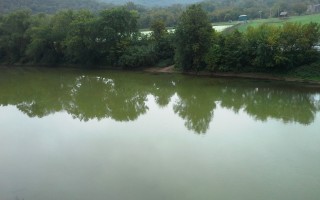
Below are some of the most frequently asked questions ICPRB has received regarding the September 23, 2015, spill in Luke, Md. If you have additional questions, please feel free to contact us. We will continue to update this page as more information is available.
Where did the spill occur and how much was spilled?
A valve in a tank that holds a synthetic latex-like chemical used to coat paper at the Verso paper mill in Luke, Md., was accidentally left open. The tank was being filled from a rail car, and the contaminant flowed into a containment area, then flowed to the wastewater treatment plant in Westernport, Md. About 10,000 gallons of the material went through treatment and into the North Branch Potomac River.
Is the contaminant toxic?
The latex is not considered a toxic substance. However, water utilities remain vigilant regarding the safety of their equipment and effects on river ecology. To date, no fish kills or other damage has been observed, and the treatment plant that the spill ran through before entering the river reported no damage to the bacterial colonies used in the treatment process.
How are the water utilities responding?
The ICPRB is working with drinking water utilities along the Potomac to keep them informed. A series of conference calls has allowed officials to communicate with each other and get briefed on the latest news. They were given estimates of the times when the contaminant plume will arrive at their intake, the peak concentration, and when the plume will be past the intake. Some of the utilities have stored water and will close their intakes until the contaminant has passed. Others further downstream have time to decide whether to close their intake, and are using this time to gather information on whether the contaminant could damage the treatment plant. Please contact your local water utility company with additional questions.
When is it expected to reach my area?
As part of ICPRB’s spill response protocol, the Emergency River Spill Model is continuously utilized to predict the travel time of the pollutant down the river. A limitation of the model is that it uses a single flow level to estimate travel time. The river is always dynamic, but especially so because of a recent upstream reservoir release and heavy rains in the watershed. The travel times are an approximation used to show utilities when they should start monitoring for the contaminant and when it will likely pass their intake. As of September 30, the contaminant plume is close to Hagerstown, Md., and will likely reach the metropolitan area water intakes on October 3. The ICPRB continues to run the Toxic Spill Model to help guide the utilities’ management decisions.
Will I have a reaction to the water if I am allergic to latex?
Although the coating substance is called “latex,” it is a synthetic compound and is not expected to affect people allergic to latex or other rubber products.
Can I still kayak/SUP/fish?
Based on current information, the substance is not harmful, but has discolored the water upstream. With the heavy rainfall predicted for the next few days, it is probably a good idea to stay off the water anyway until the contaminant passes. All this rain is quickly diluting the contaminant, and model runs predict a concentration of less than 1 part-per-million when it reaches the northern metropolitan area.
I am on a well. Will it affect my water supply?
No. There is no indication that the contaminant has entered the groundwater.
What do I do if I see a spill?
If you suspect a contaminant spill has occurred, please notify ICPRB and the appropriate agency. You can find our contact information and a list of agencies on our Spill Response page.
The red circle on the Google map above indicates the spot where the contaminant entered the river.
Looking to stay informed of spills in the Potomac River basin? Sign up for our Newsletter and follow us on Facebook and Twitter to get the updates!
Photo Credit: Jack Delawder, Paw Paw Water Plant
